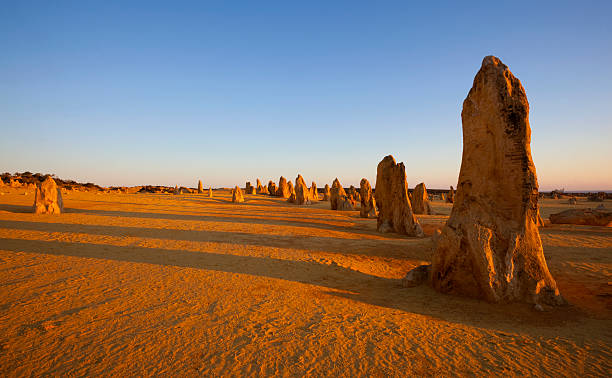When one thinks of Australia, images of bustling cities, lush rainforests, and golden beaches often come to mind. Yet, a significant portion of Australia’s landmass is dominated by deserts, vast stretches of land that are both seemingly inhospitable and strikingly beautiful. There are ten major deserts in Australia, each with its own unique landscape and ecosystem. These arid regions are integral to the country’s natural heritage, and they have been home to Aboriginal cultures for thousands of years. This article delves into the heart of Australia’s dry lands, exploring their significance, the life they harbor, and the experiences they offer to the adventurous traveler.
The Vast Deserts of Australia

Australia’s deserts cover a significant portion of the continent, carving out landscapes of solitude and resilience. Characterized by extreme temperatures and minimal rainfall, these arid zones are far from barren; they are dynamic environments with much to discover. Below is a list of Australia’s remarkable deserts.
- The Great Victoria Desert
- The Great Sandy Desert
- The Tanami Desert
- The Simpson Desert
- The Gibson Desert
- The Little Sandy Desert
- The Strzelecki Desert
- The Sturt Stony Desert
- The Tirari Desert
- The Pedirka Desert
The Red Heart – The Simpson Desert
Among all of Australia’s deserts, the Simpson Desert stands out for the iconic red sand dunes that sweep across its expanse. Often referred to as the Red Centre, it epitomizes the image of the Australian Outback. The Simpson Desert is a vast, untouched wilderness spanning over 176,500 square kilometers, making it the fourth-largest desert in Australia. Aboriginal peoples have a deep historical connection with this landscape, and it continues to be a place of cultural significance. The desert also offers a pinnacles tour for the most daring explorers, providing an opportunity to immerse in its haunting beauty.
Flora and Fauna Adaptations
The flora and fauna within Australia’s deserts are exceptional examples of nature’s adaptability. The organisms that dwell here have evolved to survive the harsh conditions, utilizing remarkable strategies to conserve water and energy. Desert plants, such as spinifex grasses, have long root systems to reach deep groundwater, and many are able to store water in their thickened stems. Animal species have adjusted their behaviors; nocturnal habits help them avoid the searing heat of the daytime sun. The famed thorny devil lizard, for instance, collects morning dew with its grooved skin to hydrate.
Human Interaction with the Desert
Humans have inhabited Australia’s deserts for over 50,000 years, with Indigenous Australians having developed deep connections and sustainable practices within these landscapes. In modern times, the deserts have various uses; some areas are significant to mining and grazing, while others are vital for conservation research and military training. Yet, despite their remoteness, these deserts attract intrepid travelers from across the globe, offering unique opportunities, from the pinnacles tour to four-wheel-drive adventures across untouched dunes.
Conservation Efforts in Australian Deserts
The conservation of Australia’s deserts is critical to protecting the unique biodiversity and the ecological integrity of these environments. Challenges such as invasive species, climate change, and land use changes pose threats to desert ecosystems. Conservation initiatives are increasingly important, with efforts focused on habitat restoration, species protection, and the reduction of carbon footprints. These actions not only preserve the deserts for future generations but also maintain the balance of Australia’s delicate arid regions.
Adventure and Tourism in Australia’s Dry Heart
Adventurers seeking a unique and exhilarating experience are drawn to the hauntingly beautiful landscapes of Australia’s deserts. The pinnacles tour in the Nambung National Park, for example, offers a glimpse into the dramatic formations shaped by the forces of nature. Below is a table showcasing some of the most iconic destinations within Australia’s deserts and the activities available for tourists.
| Desert | Destination | Activities |
|---|---|---|
| The Simpson Desert | Big Red (Nappanerica Dune) | Dune climbing, 4WD tours, camping |
| The Great Victoria Desert | Kati Thanda-Lake Eyre | Scenic flights, photography, bird watching |
| The Great Sandy Desert | Broome’s Cable Beach | Camel rides, beach activities, sunset views |
Conclusion
The deserts of Australia are as diverse as they are expansive, offering endless opportunities for discovery and adventure. From the iconic dunes of the Simpson Desert to the otherworldly Pinnacles of Nambung National Park, each arid expanse has its own story to tell. As we endeavor to protect and understand these landscapes, they continue to captivate the hearts of travelers and scientists alike. Their enduring mystique, complex ecosystems, and raw beauty leave a lasting impression on all who venture into Australia’s desolate beauty.
Frequently Asked Questions
- How many deserts are there in Australia?
Australia is home to 10 major deserts, each with its own unique ecosystem and landscape. - Which is the largest desert in Australia?
The Great Victoria Desert is the largest in Australia, covering an area of around 348,750 square kilometers. - Can you find unique wildlife in Australian deserts?
Yes, Australian deserts are home to a rich variety of wildlife, including unique reptiles, mammals, birds, and insects that have adapted to the arid conditions. - Is it possible to visit these deserts?
Many of Australia’s deserts are accessible to tourists, though visiting these remote areas requires careful planning and, in some cases, a guide or special permits. - Are Australia’s deserts growing due to climate change?
Climate change could potentially impact the deserts of Australia, leading to increased desertification. Ongoing research and conservation efforts aim to understand and mitigate these effects.
